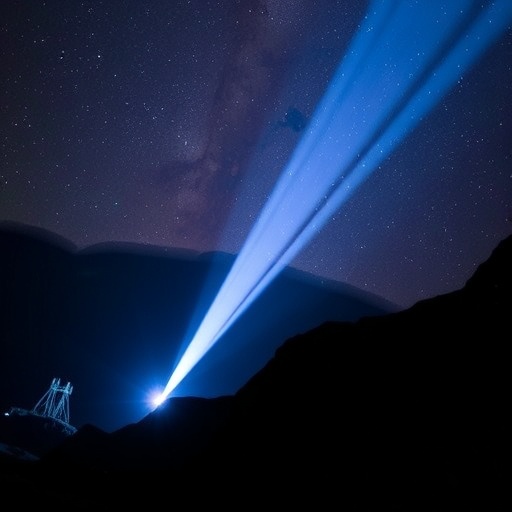In a groundbreaking advancement within the realm of particle physics and cosmology, the QROCODILE experiment has set a new benchmark in the elusive search for light dark matter. Spearheaded by teams at the University of Zurich and the Hebrew University of Jerusalem, this ambitious international collaboration has harnessed the unprecedented sensitivity of superconducting nanowire single-photon detectors operating at cryogenic temperatures near absolute zero. The results, recently published in Physical Review Letters, not only establish new world-leading limits on dark matter interactions but also chart an innovative course toward unraveling one of physics’ most persistent enigmas.
Dark matter remains one of the universe’s most mysterious constituents, comprising approximately 85% of its total mass-energy content yet evading direct detection due to its non-interaction with electromagnetic radiation. Historically, conventional detection methods have focused on heavier dark matter candidates, whose interactions with ordinary matter should produce relatively high-energy signals. However, these efforts have turned up empty, prompting researchers to probe the possibility that dark matter particles exist with masses far below a mega-electron-volt (MeV), in a realm termed “light dark matter.”
QROCODILE — an acronym for Quantum Resolution-Optimized Cryogenic Observatory for Dark matter Incident at Low Energy — represents a paradigm shift in detection strategy. Rather than relying on traditional scintillators or semiconductor crystals, the experiment exploits the exceptional properties of superconducting nanowires cooled to cryogenic temperatures. These nanowires detect minuscule energy deposits on the order of 0.11 electron-volts (eV), which translates to capturing signals millions of times less energetic than those typically observed in particle physics detectors. This technological leap enables probing interactions with hypothetical dark matter particles possessing sub-MeV masses, a range that was previously inaccessible.
During a comprehensive physics run spanning over 400 hours, the QROCODILE team maintained detector operation at temperatures infinitesimally above absolute zero to minimize thermal noise and environmental backgrounds. This prolonged data acquisition period allowed the detectors to accumulate a statistically significant dataset. Within this dataset, researchers identified a limited number of anomalous events—energy depositions deviating from known background noise models. While still inconclusive as direct dark matter detections, these signal candidates serve as critical inputs to tighten experimental constraints on how light dark matter may scatter off electrons and nuclei.
One of the experiment’s most innovative features is the potential to ascertain the directionality of incoming particle interactions. As our Solar System traverses the Milky Way’s dark matter halo at about 220 kilometers per second, dark matter particles should preferentially arrive from a distinct direction relative to Earth. Detecting this anisotropy acts as a powerful discriminant between genuine dark matter events and terrestrial or cosmic ray-induced backgrounds. QROCODILE’s superconducting detectors promise future upgrades that could exploit this directional dependence, a capability that would represent a monumental stride toward unequivocal dark matter identification.
The sophisticated engineering behind QROCODILE leverages the quantum resolution of superconducting nanowires, where photon absorption induces a rapid, detectable change in the wire’s resistance state. This transition is registered with exquisite timing and energy resolution, enabling the distinction of single-photon events originating from particle interactions. Operating at temperatures near 10 millikelvin, the superconducting state is preserved, ensuring minimal jitter and noise, and thus pushing detector sensitivity to unprecedented lows.
Collaborative efforts underpinning the QROCODILE project are notable for their breadth, integrating expertise from Cornell University, Karlsruhe Institute of Technology (KIT), and the Massachusetts Institute of Technology (MIT), alongside the lead institutions. This multidisciplinary synergy has allowed the amalgamation of cutting-edge cryogenic technology, quantum sensor innovation, and astroparticle physics models, positioning the experiment at the intersection of theoretical and experimental frontiers.
Prof. Yonit Hochberg of the Racah Institute of Physics at the Hebrew University, a principal investigator, articulated the significance of these initial limits: “For the first time, we’ve placed new constraints on the existence of especially light dark matter. This is an important first step toward larger experiments that could ultimately achieve the long-sought direct detection.” Her remarks underscore the profound implications of pushing sensitivity boundaries into energy regimes where dark matter might reveal its subtle interactions.
The forthcoming phase of the experiment, dubbed NILE QROCODILE, intends to capitalize on these promising results by relocating the detector array underground. This strategic move will drastically reduce cosmic ray background interference, a perennial challenge in low-energy particle detection. Moreover, upgrades plan to expand the detector array, enhance shielding materials, and refine energy threshold performance below existing levels, thus amplifying the experiment’s discovery potential.
The success of QROCODILE brings renewed optimism to the campaign against one of fundamental physics’ greatest hurdles: deciphering the true nature of dark matter. By narrowing the landscape of viable particle models and progressively tightening constraints on dark matter’s coupling to the Standard Model, QROCODILE fosters a fertile ground for discoveries that could reshape our cosmic understanding. The experiment’s technological innovations also convey broader implications for quantum sensing and low-energy particle physics.
Ultimately, QROCODILE epitomizes how quantum technologies, when harnessed in extreme cryogenic environments, offer unprecedented probes into the dark corners of the universe. Its pioneering detection approach, blending minute energy sensitivity with directional measurement capabilities, sets a blueprint for next-generation dark matter searches. As the scientific community anticipates escalation on both detector scale and precision, QROCODILE’s trailblazing journey heralds a new era in astrophysics and quantum measurement.
As dark matter continues to challenge our grasp of the cosmos, experiments like QROCODILE illuminate a path through this opaque frontier. With meticulous design, international collaboration, and innovative quantum instrumentation, the quest for light dark matter is no longer a speculative endeavor but an attainable scientific mission. The coming years will witness whether these subtle signals evolve from tantalizing hints to definitive evidence, potentially unlocking the secrets of the universe’s most enigmatic substance.
Article Title: First Sub-MeV Dark Matter Search with the QROCODILE Experiment Using Superconducting Nanowire Single-Photon Detectors
News Publication Date: 20-Aug-2025
Web References: DOI: 10.1103/4hb6-f6jl
Keywords
Physics, Dark matter, Superconductivity, Single photon sources




